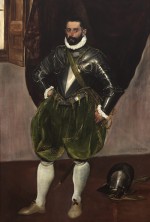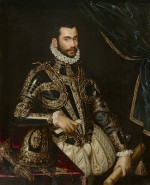Column Name
Title

Henri Matisse: The Parakeet and the Mermaid (1952), gouache on paper, cut and pasted, and charcoal on white paper, 11 feet 11/16 inches by 25 feet 2 9/16 inches.
(Photo by Museum of Modern Art)In New York City, there always seems to be more art than any one person can take in. This season will be no different; as usual, the problem is how and what to choose to see. Here follow a few suggestions.
El Greco: Vincenzo Anastagi (c. 1575), oil on canvas, 74 by 49 inches
(Photo by The Frick Collection)Scipione Pulzone: Jacopo Boncompagni (1574), oil on canvas (48 x 39 inches)
(Photo by Private collection, courtesy of Jean-Luc Baroni Ltd.)Henri Matisse: Two Masks (The Tomato) (Deux Masques [La Tomate]) (1947), gouache on paper, cut and pasted, 18 3/4 x 20 3/8 inches
(Photo by Museum of Modern Art)Body
First of all, the Museum of Modern Art—where Juilliard students always have free admission—will host several new and exciting exhibitions.
The Paris of Toulouse-Lautrec: Prints and Posters, a long anticipated show, comprises more than 100 prints and posters, all belonging to the museum’s own collection. For this exhibit, the first comprehensive one MoMA has dedicated to the artist in 30 years, many works ordinarily hidden away in storage will be displayed. It’s up through March 22.
Henri de Toulouse-Lautrec (1864-1901), the most celebrated of the Belle Époque Parisian artists, holds special interest for performing artists since he spent most of his time drawing in theaters, dance halls, and cabarets. In fact, the immortalization of many of the performers of his time can be traced to his posters and prints. Lautrec idolized Edgar Degas (1834-1917), an artist especially well known to dancers. But unlike Degas, who spent long hours of study, during which he painstakingly drew and painted in a classical manner (“Nobody is less spontaneous than I,” Degas once said), Lautrec made quick sketches at the nightclubs he frequented. Later, influenced by Japanese ukiyo-e woodblock prints, he transformed these into some of the first—and also greatest—fine art posters. In them Lautrec utilized curvy, sinuous lines, hallmarks of the Art Nouveau movement, and flat areas of color to emphasize distinguishing characteristics of his subjects.
Lautrec’s keen insight and psychological perception raise his work far above commercial art; it also bridges the gap between high and low, between performers and patrons, and between prostitutes in brothels and high society. You will recognize some of his notorious characters, such as the red-scarfed, black-caped Aristide Bruant in his cabaret; Yvette Guilbert, with her long black gloves; Jane Avril in black dress adorned with a snake design (which Lautrec most likely invented); and the innovative American Art Nouveau dancer Loïe Fuller, who seemed to fly as she directed beams of colored light onto voluminous folds of silk. Lautrec’s name will be forever associated with the Moulin Rouge.
Also coming to MoMA (October 12-Februry 8) will be the much-heralded Henri Matisse: the Cut-Outs. Matisse (1869-1964), a colossus of modern art, cannot easily be categorized. This exhibition focuses on the artist’s last decade of life, during which he suffered ill health and was confined to a wheelchair. No longer able to paint, he instead cut out large colored shapes, arranging them in formal patterns. He called it “painting with scissors” and hired assistants to carry out the final products. Interestingly, this new technique offered Matisse greater freedom than painting had, and it had a powerful effect on many 20th-century artists. The inspiration for this exhibit arose from the museum’s recent conservation of the artist’s room-sized cut-out The Swimming Pool (1952), which has been a favorite of visitors since MoMA acquired it in 1975. Matisse had designed it for his own dining room in Nice; it has not been on view for 20 years. While it is the centerpiece of the exhibition, there will also be more than 100 cut-outs borrowed from museums and collectors around the world. Visitors will need to purchase timed entries to see this exhibit, which is bound to draw crowds.
A groundbreaking Neue Galerie exhibit is Egon Schiele: Portraits (October 9-January 19). Curated by Alessandra Comini, a world-renowned Schiele scholar (and my professor at Columbia), the show includes approximately 125 paintings, drawings, and sculptures. Despite his tragically short lifetime, Schiele (1880-1918) is considered one of the foremost Expressionist artists of the 20th century. Along with his mentor Gustav Klimt (1862-1918) and fellow Austrian artist Oskar Kokoschka (1886-1980), Schiele had a strong impact on the course of modern art in Europe.
His work can be compared with the art and music of his contemporary, Arnold Schoenberg; and Schiele’s 1917 portrait of the composer is included in this show. Some of Schiele’s nude, distorted, mangled, and raw images parallel those of Schoenberg’s imaginative and strange painted figures and Gazes paintings (c. 1910-12). And Schoenberg’s monodrama Erwartung (1909) delves into the psyche of a woman much in the same way that Schiele seeks to reveal taboo-laden sexual drives. Schiele’s work was considered so shocking at the time that he was imprisoned for pornography (as well as a trumped-up charge of seducing a minor). Schiele, Schoenberg, and Sigmund Freud (1856-1939), who were all living in Vienna at about the same time, paved the way for Surrealism and other 20th-century movements. Federico de Vera, the exhibition designer, hopes to make it an authentic experience by borrowing from design principles popular in Austria during the early 20th century.
The Morgan Library will be showing The Untamed Landscape: Théodore Rousseau and the Path to Barbizon (September 26-January 18). Rousseau (1812-1867), Camille Corot, and Jean-François Millet made up the Barbizon School, a group of artists who concentrated on nature and the out-of-doors, sketching and painting the forest of Fontainebleau. Influenced by Dutch 17th-century landscape painting and English Romanticism, they, in turn, inspired the Impressionists. This show, the first, devoted solely to Rousseau, comprises 70 works, some borrowed from other collections, while some are the Morgan’s own.
On a quite different note, New York City is the home of several paintings by the extraordinary master, El Greco (1540/41-1614). To commemorate the 400th anniversary of the artist’s death, the Frick Collection focuses on the artist with Men in Armor: El Greco and Pulzone Face to Face (through October 26), as well as coordinating another installation featuring El Greco at the Metropolitan Museum of Art (November 4-Feburary 1). The Frick owns three El Grecos, and they will be shown alongside each other for the first time. The other exhibit pairs the artist’s Vincenzo Anastagi with the rarely seen Jacopo Boncompagni by the artist’s Roman contemporary Scipione Pulzone (c. 1540/42–1598). The Met’s El Grecos, some of the finest in the world, include View of Toledo, Cardinal Don Fernando Niño de Guevara, and The Vision of Saint John.
While visiting these exhibitions, you should absolutely see other shows and other parts of these extraordinary museums. The Met and MoMA are among New York City’s major tourist attractions, but smaller gems, like the Neue Galerie, the Morgan Library, and the Frick can sometimes be overlooked.



![Henri Matisse: Two Masks (The Tomato) (Deux Masques [La Tomate]) (1947) Henri Matisse: Two Masks (The Tomato) (Deux Masques [La Tomate]) (1947)](http://journal.juilliard.edu/sites/journal.juilliard.edu/files/styles/journalside_smartport/public/journal/2014/09/museum_of_modern_art.jpg?itok=A4iTHaln)




